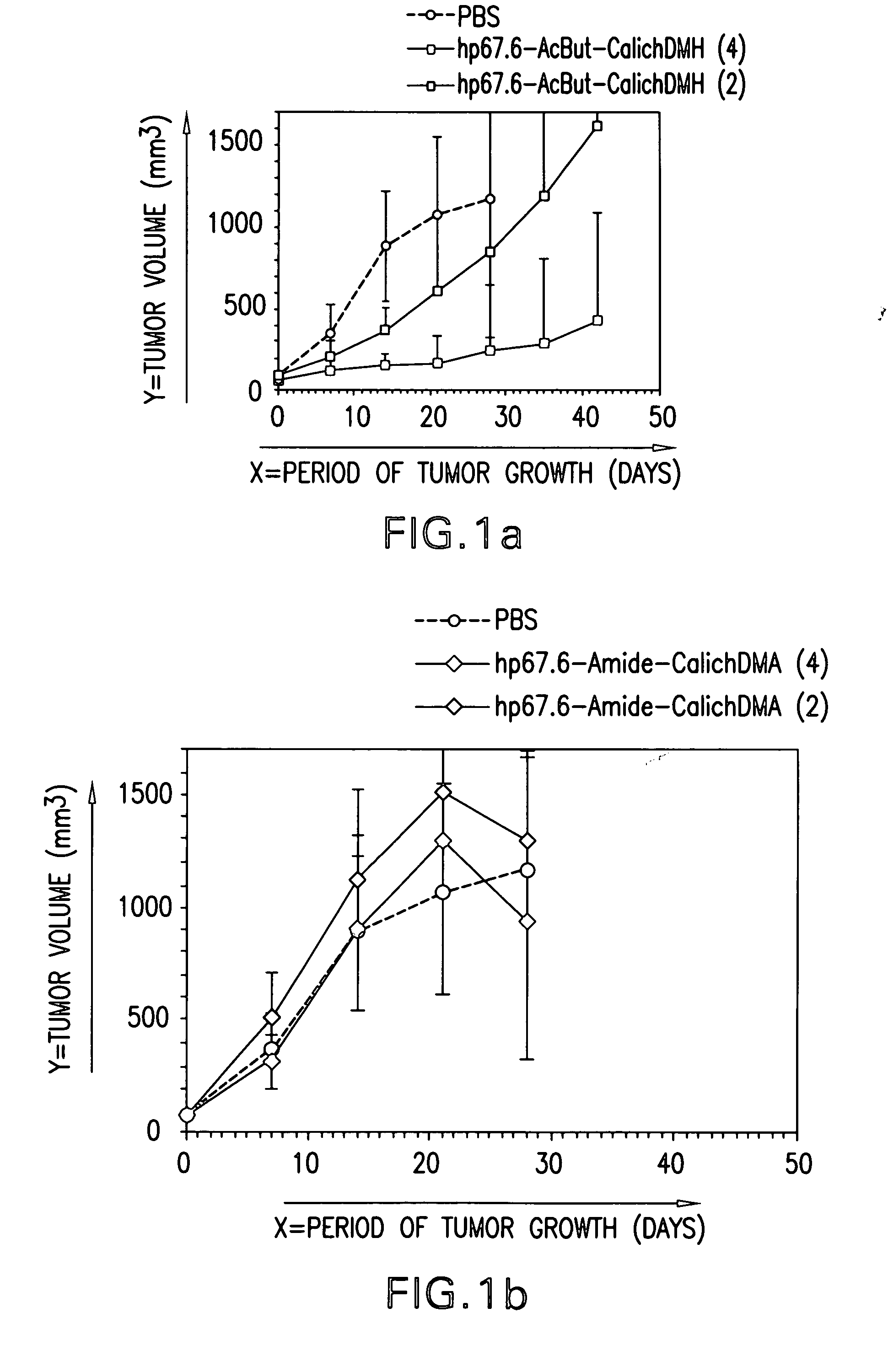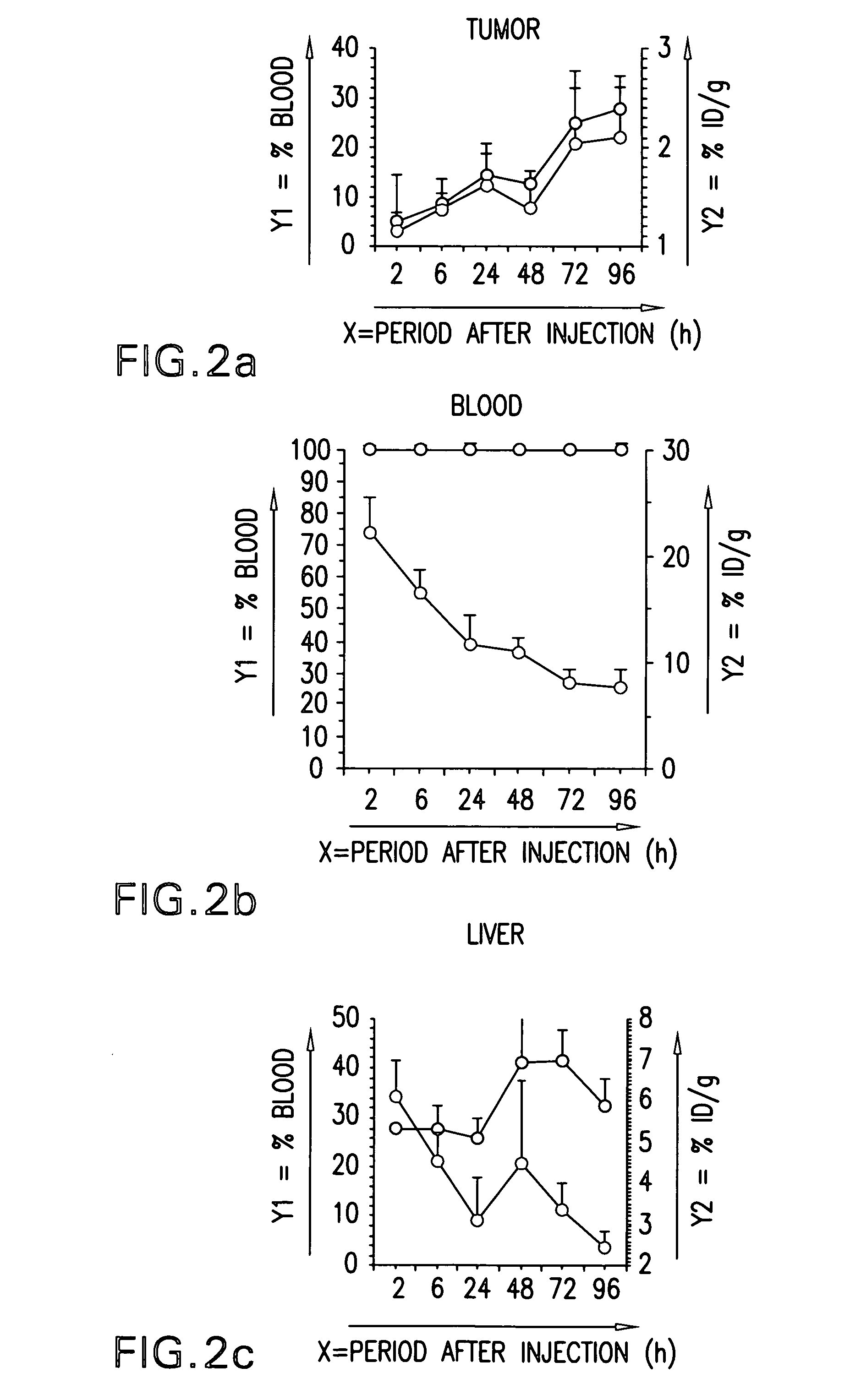Passive targeting of cytotoxic agents
a cytotoxic agent and passive targeting technology, applied in the field of passive targeting of cytotoxic agents, can solve the problems of not achieving complete remission in a majority of cancers, use of targeted cytotoxins in developing therapies, and formation of protein aggregates
- Summary
- Abstract
- Description
- Claims
- Application Information
AI Technical Summary
Benefits of technology
Problems solved by technology
Method used
Image
Examples
example 1
Materials and Methods
[0084] Calicheamicin Conjugates
[0085] Calicheamicin analogues were conjugated to various carrier molecules with either acid labile or acid stabile linkers. The acid labile 4-(4′-acetylphenoxy)butanoic acid (AcBut) or (3-Acetylphenyl)acetic acid (AcPAc) allow for acid hydrolysis of the hydrazone group and for disulfide reduction in the lysosomes. The acid stabile 4-mercapto-4-methyl-pentanoic acid (Amide) allows only for dissociation at the disulfide group. The calicheamicin analoges, N-acetyl-γ-calicheamicin dimethyl hydrazide (CalichDMH) or N-acetyl-γ-calicheamicin dimethyl acid (CalichDMA) were conjugated with acid labile or acid stable linkers, respectively.
[0086] Cells and Culturing Conditions
[0087] N87 (CRL-5822), HT29 (HTB-38), LOVO (CCL-229), A431 (CRL-1555) and LNCaP (CRL-1740) were purchased from the American Type Culture Collection (ATCC). Cell lines obtained from ATCC were maintained in culture medium as specified in the ATCC-catalogue. L2987 was ...
example 2
Efficacy of HU3S193-DMH In Vivo
[0100] Subcutaneous tumors of N87, LOVO, A431 / Ley, LS174T and L2987 were grown in athymic nude mice (Charles River, Wilmington, Mass.). Two-month-old female mice were injected with respectively 5×106 N87, LOVO, A431 / Ley or LS174T cells per mouse. L2987 cells were injected in male nude mice that were between 7 and 8 weeks old. To grow tumors, N87 cells had to be mixed (1:1, vol / vol) with MATRIGEL® (Collaborative Biomedical Products, Belford, Mass.) prior to injection. Two perpendicular diameters of the tumor were measured by means of calipers at time intervals specified in the result section. The tumor volume was calculated according to the formula of Attia&Weiss: A2×B×0.4. A and B are symbols for the smaller and the larger tumor diameter, respectively. The treatment schedules, dose and number of mice per group are specified in the result section and in the figure legends.
example 3
In Vivo Distribution of 125I-Labeled Conjugate
[0101] Gemtuzumab ozogamicin was labeled with 125I using the Bolton-Hunter reagent (NEN, Boston, Mass.). A group of 30 tumor-bearing female nude mice were injected in the lateral tail vein with 125I-labeled conjugate 20 μCi / 200 mg. The tumor weight at the time of injection was approximately 1 g. Groups of 5 mice were killed by CO2 inhalation at 2, 6, 24, 48, 72 and 96 h following the injection. The amount of γ radiation in the tissues as specified in FIG. 2 was determined at these time points. Biodistribution of the conjugate was expressed as a percentage of the injected dose per gram tissue (% ID / g) or as a percentage of the blood level at a given time point (% Blood). Steadily increasing concentrations of hp67.6-AcBut-CalichDMH were exclusively observed in tumor tissue. The doubling time of accumulation is 150 h for A431 tumors.
PUM
| Property | Measurement | Unit |
|---|---|---|
| pH | aaaaa | aaaaa |
| pH | aaaaa | aaaaa |
| MW | aaaaa | aaaaa |
Abstract
Description
Claims
Application Information
 Login to View More
Login to View More - R&D
- Intellectual Property
- Life Sciences
- Materials
- Tech Scout
- Unparalleled Data Quality
- Higher Quality Content
- 60% Fewer Hallucinations
Browse by: Latest US Patents, China's latest patents, Technical Efficacy Thesaurus, Application Domain, Technology Topic, Popular Technical Reports.
© 2025 PatSnap. All rights reserved.Legal|Privacy policy|Modern Slavery Act Transparency Statement|Sitemap|About US| Contact US: help@patsnap.com



